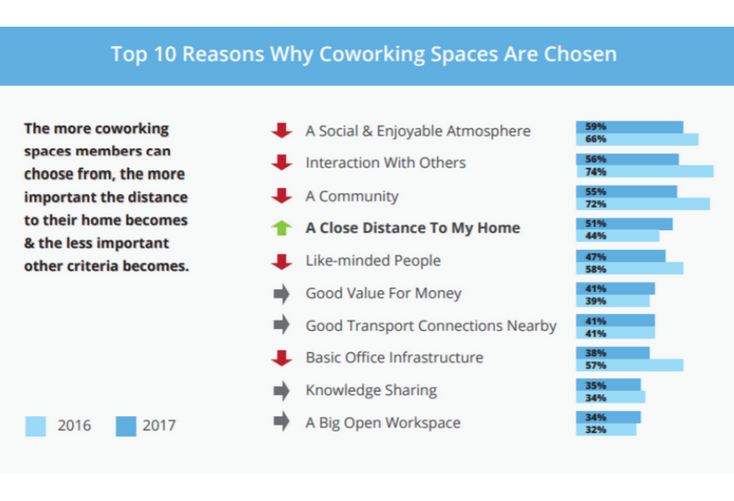- Agile workplace environments are dynamic and nimble in their approach to support organizational objectives and employee needs.
- It has the potential to positively impact suburban settings and give workplace users a better experience and the ability to connect with people.
- Allwork.Space spoke with Beth Moore, CBRE Americas Agile Real Estate Practice Leader, to learn more about the changing workplace landscape.
The way we work and the places we work in are essentially different today than they were 5, 10, and more years ago. And the change isn’t over; in fact it will only continue to accelerate its pace.
CBRE’s whitepaper “The Agile Advantage” claims that this “evolving landscape of work has (had) very real implications for real estate, creating a new wave of expectations and opportunities. Owners, occupiers and service providers are looking for new models—grounded in the concept of agility—to deliver highly effective workplaces, differentiated assets and optimized portfolios that yield more value for the organizations and the people they serve.”
It’s the world of agile real estate. But what exactly is it?
CBRE defines agile real estate as “workplace environments and space agreement structures, that are dynamic and nimble in supporting organizational objectives and employee needs–today and tomorrow.”
Flexible workspace operators have essentially been doing this for over 20+ years; although it wasn’t until recent years that the product offering evolved and specialized with the introduction of coworking, incubators, and accelerators. And it was only in the course of the past 18-24 months that operators became truly agile, when they started to look to alternative lease agreements and management contracts as a business opportunity.
Beth Moore, CBRE Americas Agile Real Estate Practice Leader, believes this change is powered by the simple fact that “people are looking for a different experience when they come in to the work environment; and this is forcing companies to combine technology, services, and amenities.”
Moore adds that the role of technology has been pivotal in the development of agile real estate and engaging workplaces. “With the ability to work anywhere the importance of place making and connecting with people is more important today than ever before. This is among the main reasons why companies are seeking to create workplaces that draw in people and encourage them to interact.”
Yet companies have also realized they aren’t necessarily the best options to create these desirable environments.
With agile real estate comes a different and more flexible workplace strategy. Companies of all sizes have started to look to coworking and flexible workspaces as one way to retain people, engage them, and offer them the flexibility they want.
“Workplace strategy today is for many companies their ability to create an ecosystem of places that people can choose to work from.”
Agility in Suburban Areas
Agile real estate has the potential to positively impact suburban settings. “People who live in the suburbs have long commutes to go into the city; and the only reason they go into the city is because they want a better experience and they want to connect with people.”
In the ebook “Making Smart Real Estate Decisions for Your Coworking Space”, WUN Systems addresses this issue stating that secondary or even tertiary markets can provide a strong starting point for operators prior to market saturation and at a generally lower price. Moreover, as choice continues to increase, WUN found that people will start to look to space proximity as a key differentiator.

Suburban areas are an untapped market and they represent a huge opportunity for flexible workspace operators. According to Moore, “suburban office markets are in the best position to capture coworking and the live+work+play dynamic.”
Agility and Amenities
Landlords and investors are taking note of the importance of agile real estate and they are thinking of ways in which they can activate the community settings in their properties. Moore adds that these players are considering “integrating an amenity floor or a coworking space into their buildings to help with the ebb and flow of the space. Their main concern is: ‘how can I activate all of the areas within the community space to draw individuals and tenants into the environment?’”
Moore shares that this activation is possible through the right amenities.
“It’s got to have great coffee; I think this has become a standard, as well as great technology, lots of electric outlets available and comfortable furniture. I will also say that there is a huge appetite for wellness, and event space when combined with unique programming has shown positive results in attracting people.
In the end, what agility is providing is the opportunity to think more creatively about space.


 Dr. Gleb Tsipursky – The Office Whisperer
Dr. Gleb Tsipursky – The Office Whisperer Nirit Cohen – WorkFutures
Nirit Cohen – WorkFutures Angela Howard – Culture Expert
Angela Howard – Culture Expert Drew Jones – Design & Innovation
Drew Jones – Design & Innovation Jonathan Price – CRE & Flex Expert
Jonathan Price – CRE & Flex Expert












